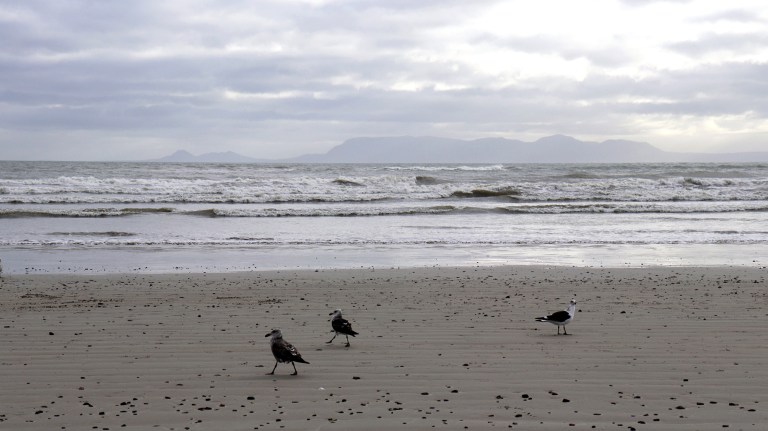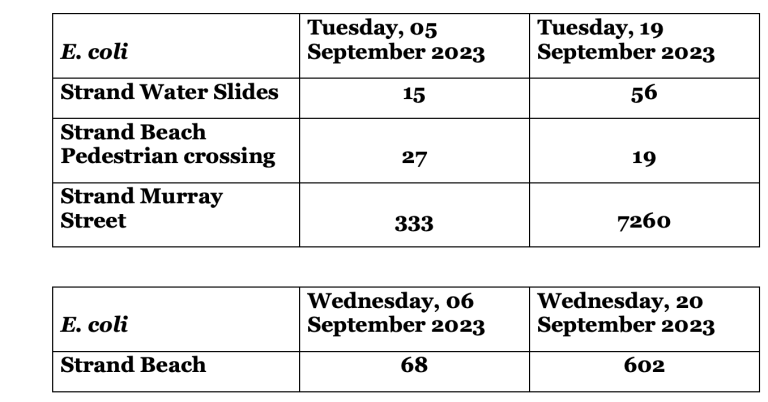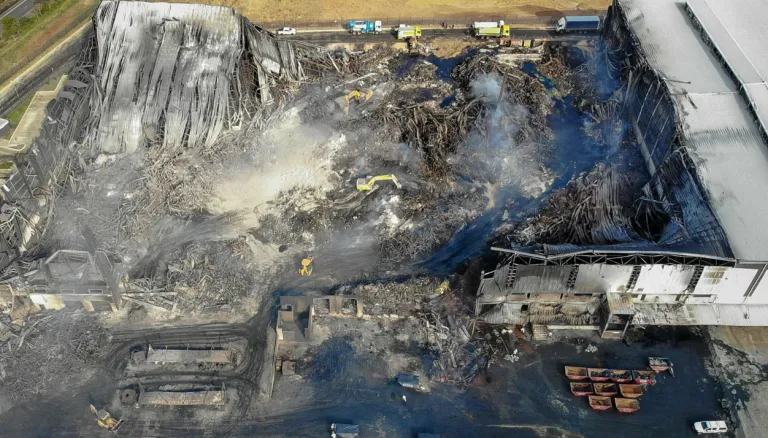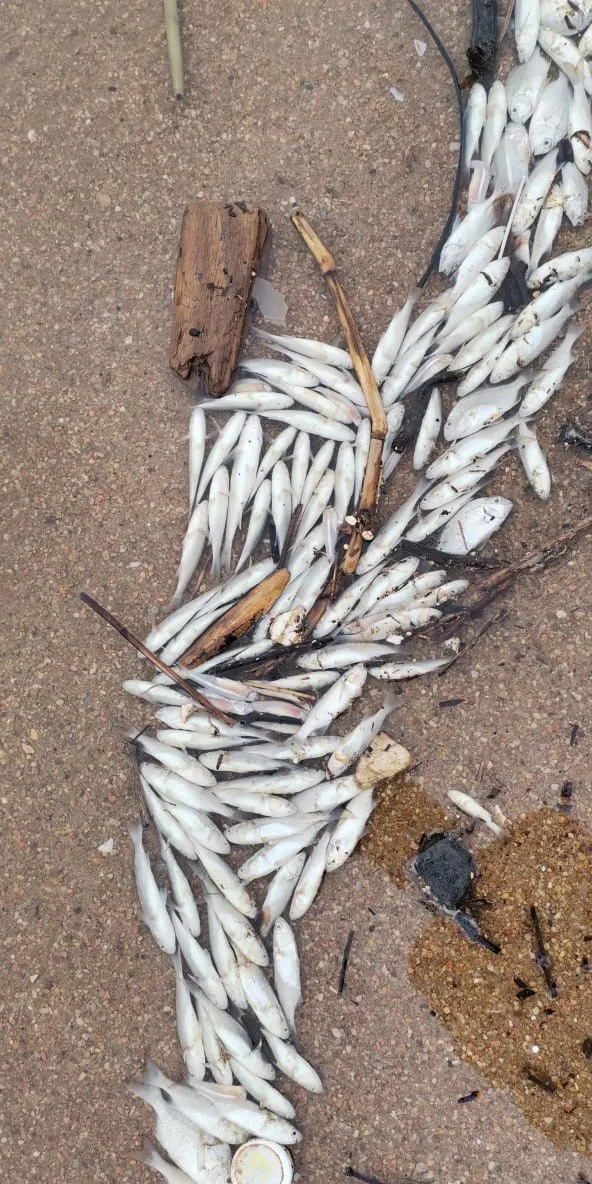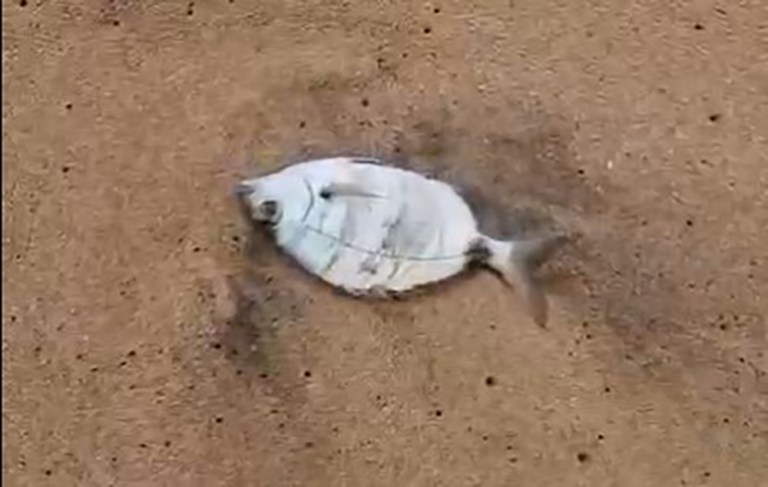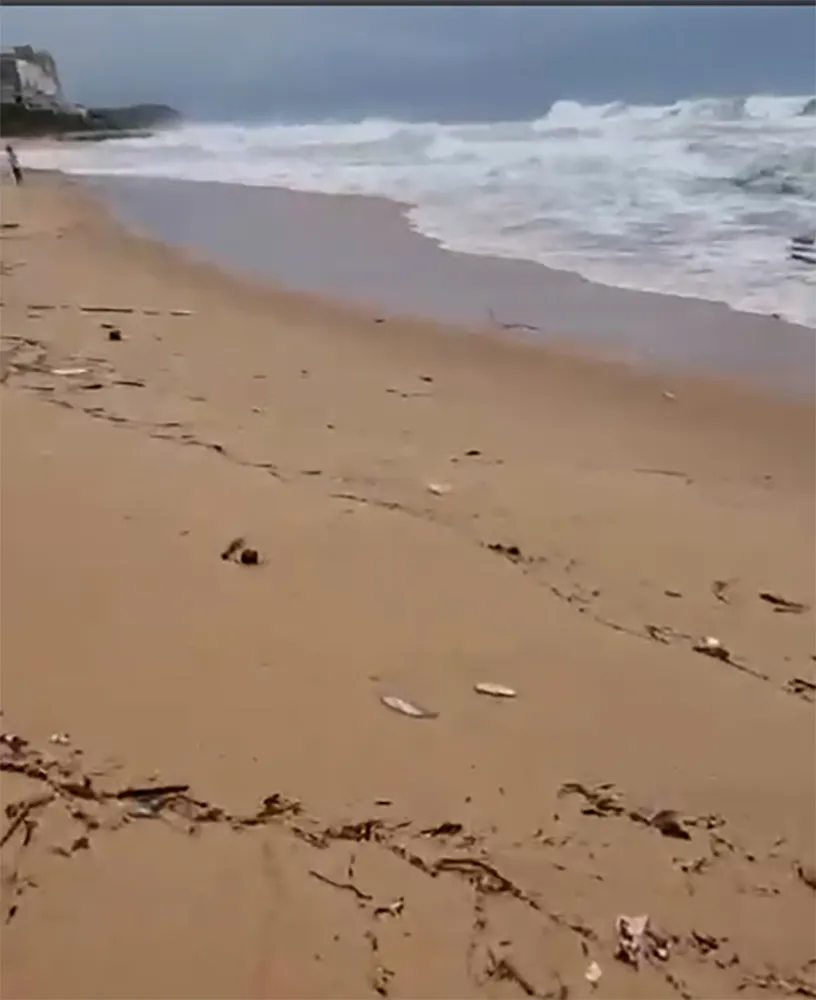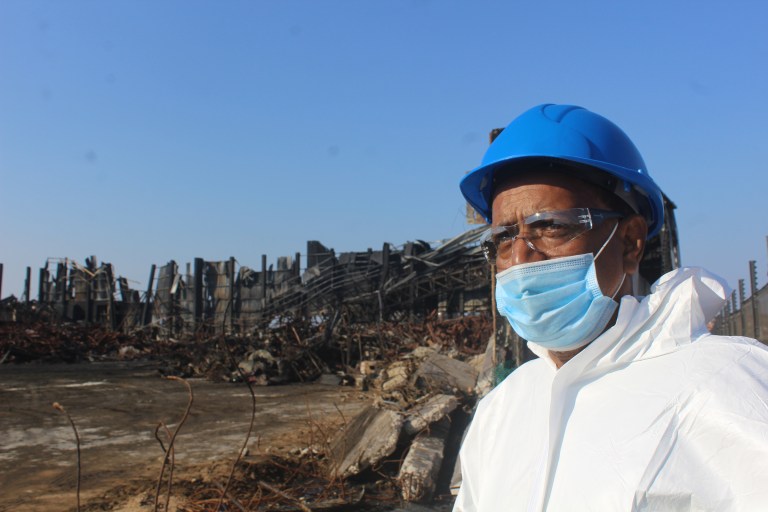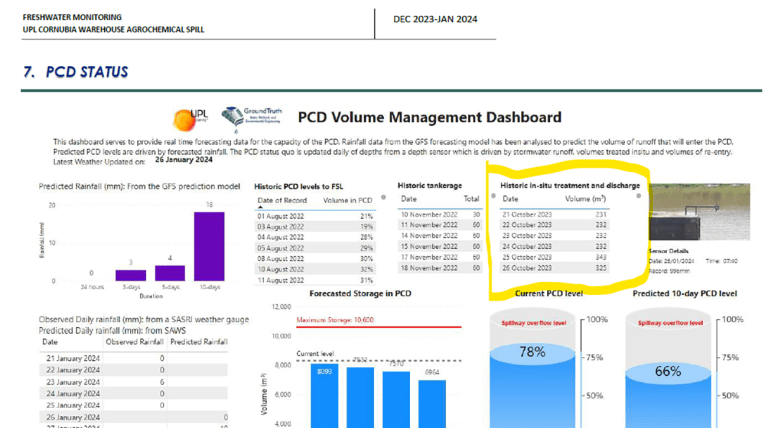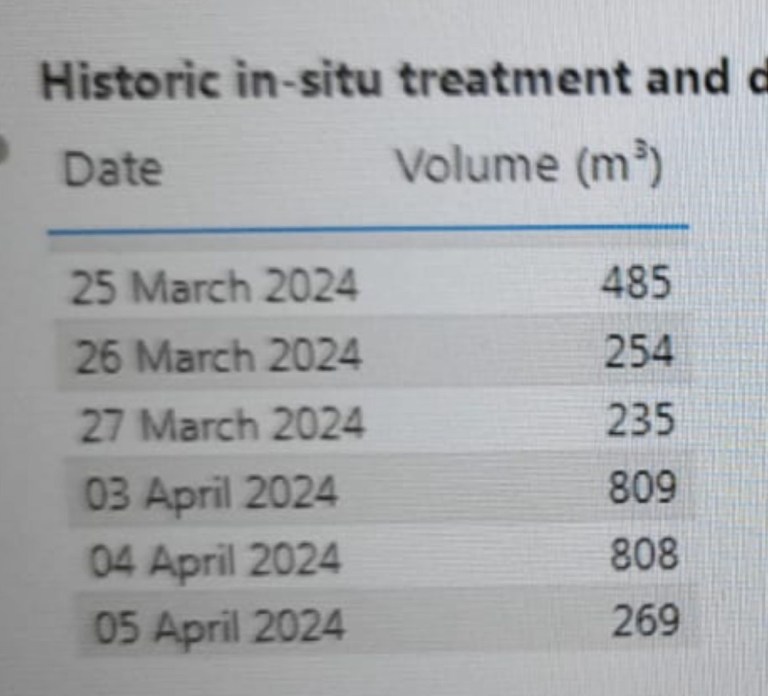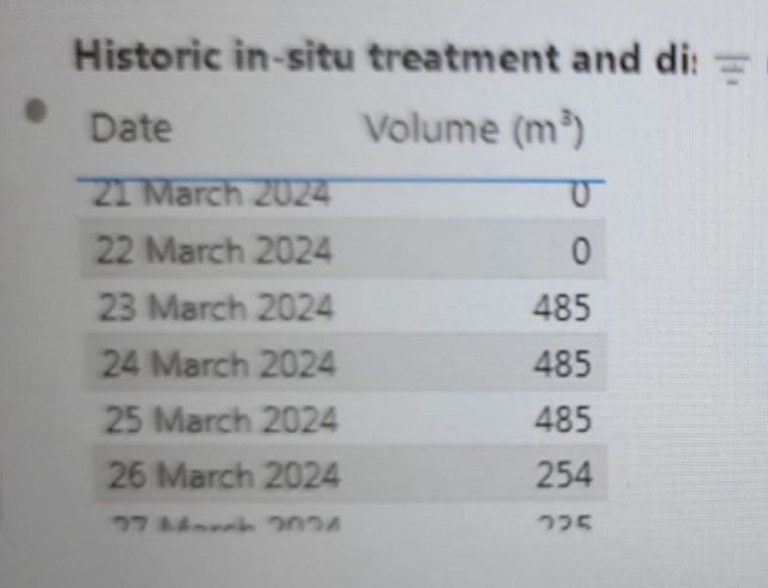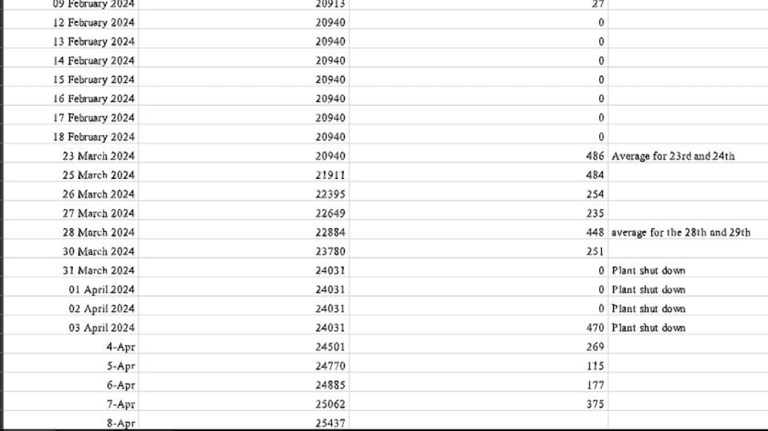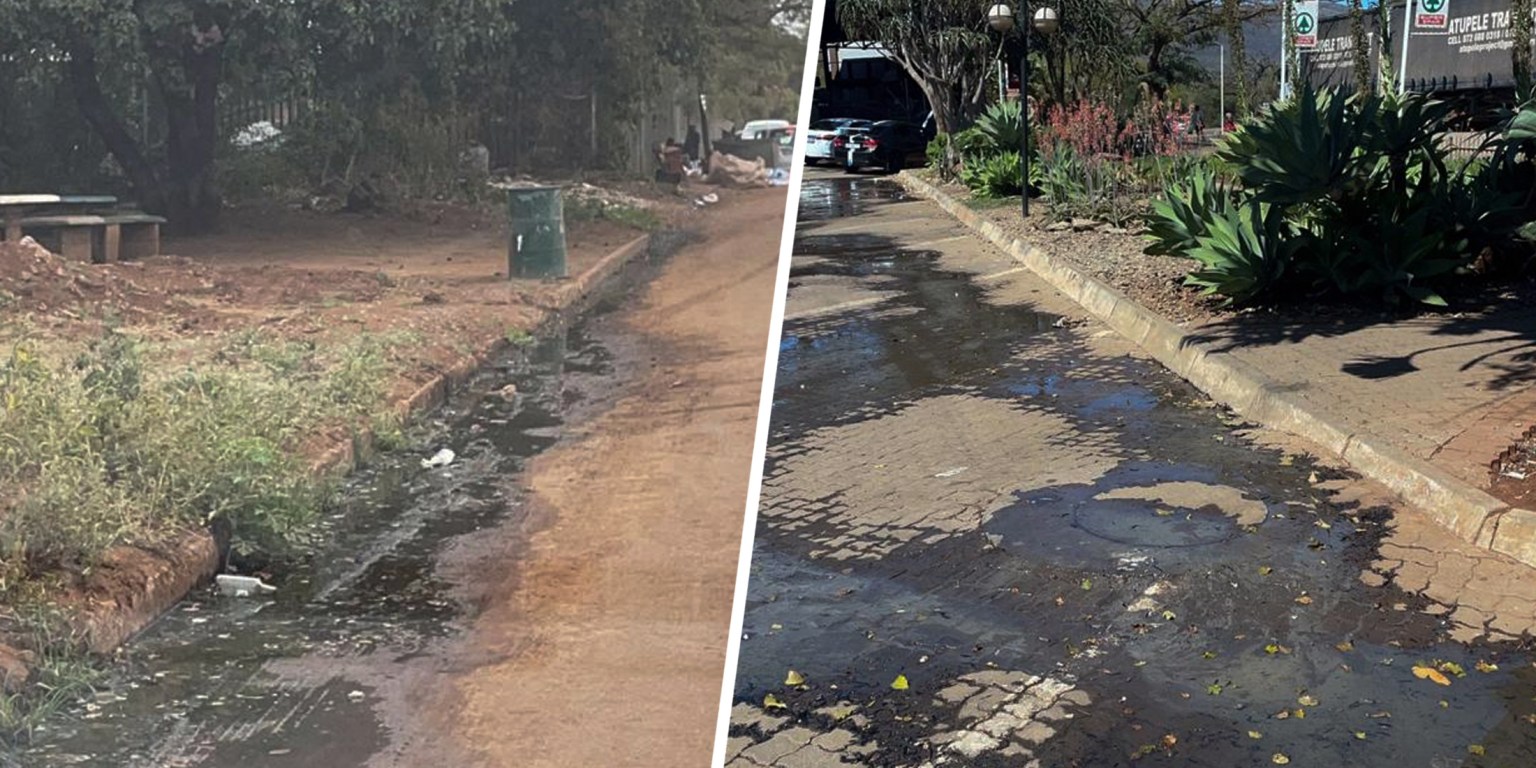UPL asked to explain how ‘Agent Orange’ war poison chemical ended up in Durban river
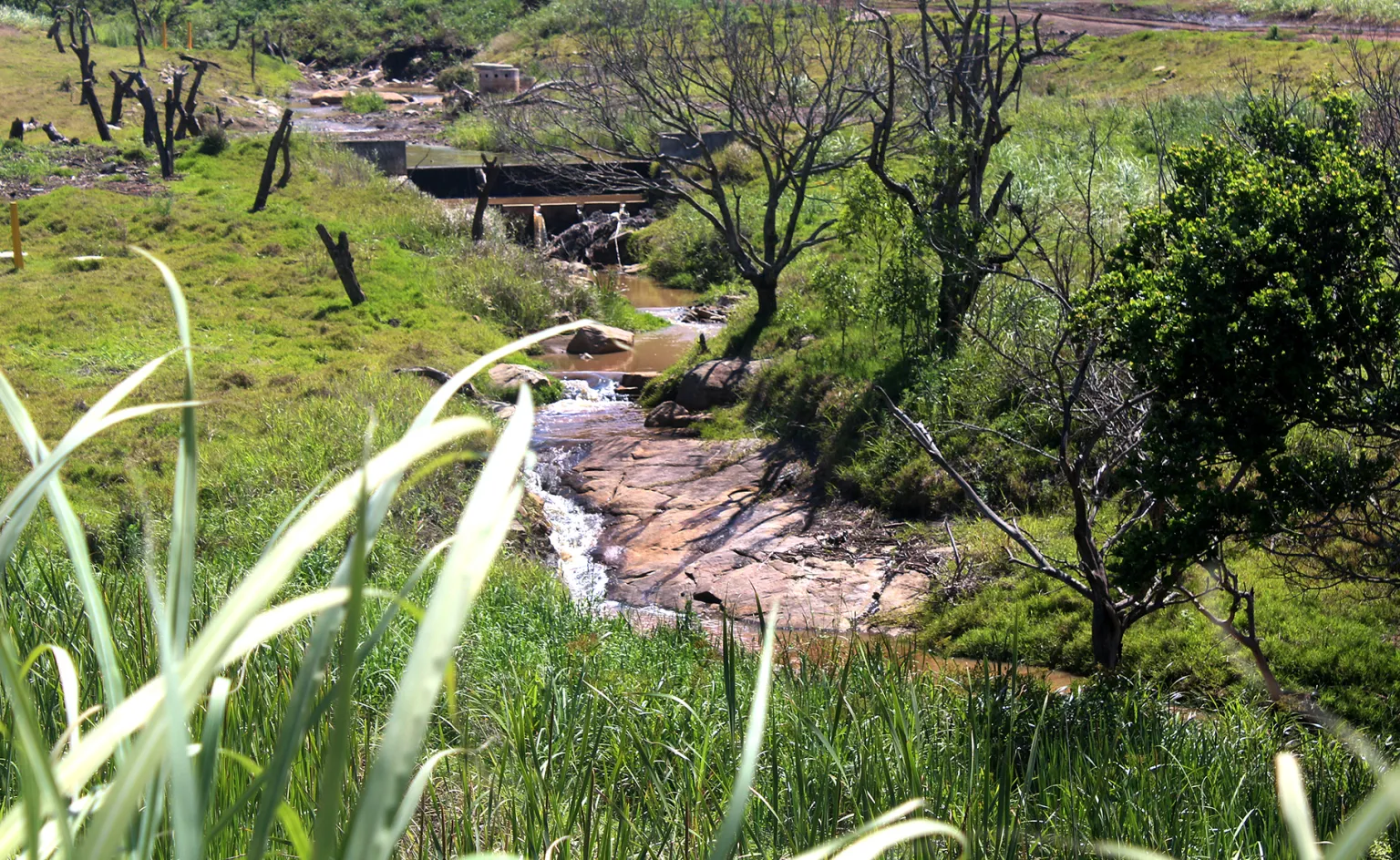 Water from the UPL chemical treatment plant flows into a tributary of the Ohlanga River in Durban (Photo: Tony Carnie)
By Tony Carnie | 11 Dec 2023
Water from the UPL chemical treatment plant flows into a tributary of the Ohlanga River in Durban (Photo: Tony Carnie)
By Tony Carnie | 11 Dec 2023
The banned pesticide 2,4,5-Trichlorophenoxyacetic acid has been found in samples collected by consultants looking into the aftermath of the UPL chemical fire. The company says it ‘never imported, stored, or traded this compound’.
___________________________________________________________________________________________________________________________
The discovery of a highly toxic, globally banned pesticide in water and soil samples north of Durban has heightened concerns around the poisonous aftermath of the UPL chemical inferno in July 2021.
The pesticide 2,4,5-Trichlorophenoxyacetic acid (2,4,5-T), was an ingredient of “Agent Orange” — a poisonous cocktail sprayed by the US military to defoliate jungles during the Vietnam War and later linked to a variety of serious human health and environmental impacts.
This pesticide was first banned domestically in parts of South Africa in the late 1980s after being linked to vegetable crop malformations in the Tala Valley in KwaZulu-Natal and also banned or severely restricted internationally through the Rotterdam Convention of 2004. Since 1984, it has been banned in India (UPL’s global headquarters).
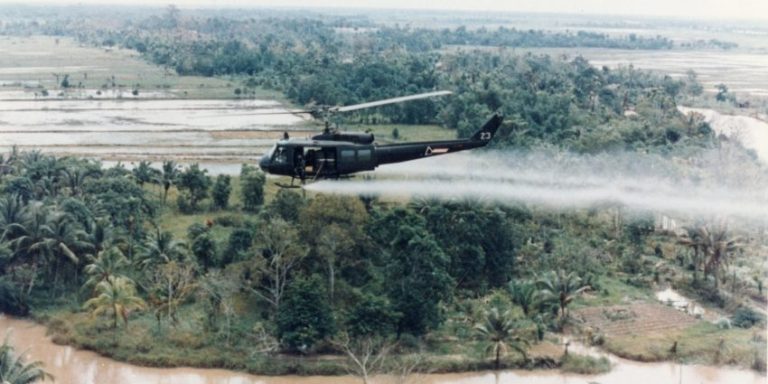 US military helicopter spraying Agent Orange over Vietnam (Photo: US Army / Wikimedia Commons)
US military helicopter spraying Agent Orange over Vietnam (Photo: US Army / Wikimedia Commons)
However, it was not listed in a disclosure to the government by the Mumbai-based UPL group as being among the thousands of tonnes of chemicals that burnt or leaked next to residential areas alongside its warehouse in Cornubia, Durban.
Now it has come to light that significant levels of 2,4,5-T have been detected in several samples of soil and water in the immediate vicinity of the warehouse and in the Ohlanga Estuary over the past 2½ years — including samples collected directly from the fire-blackened floor of the Cornubia storehouse.
Daily Maverick has seen evidence confirming the presence of 2,4,5-T in numerous samples collected by UPL consultants, even though strict measures are in place globally to prohibit the import or export of this highly hazardous pesticide without specific notification to the Secretariat of the Rotterdam Convention. This is a global treaty signed by 165 countries to provide early warning to countries about a broad range of hazardous chemicals that are traded internationally.
Now UPL is under pressure to explain exactly how this chemical ended up polluting land and water in Durban.
The Cornubia Multi-Stakeholder Forum (MSF) — a civil society watchdog group established after the UPL warehouse was set alight during the July 2021 riots — says the presence of this pesticide in laboratory samples suggests that the substance entered South Africa unlawfully and that the country may have breached the Rotterdam Convention.
In a letter sent to several government departments last week (and copied to UPL management), Durban attorney and MSF convenor Jeremy Ridl said the discovery of 2,4,5-T in Durban would be referred to the Rotterdam Convention Secretariat in Switzerland for investigation.
It would also be reported to Marcos Orellana, the United Nations special rapporteur on toxics and human rights, who visited South Africa in August.
Ridl has also questioned why South Africa’s national Department of Environmental Affairs did not appear to have queried the discovery of a banned chemical in sample test results and taken appropriate action after tests dating back to 2021 revealed its presence inside or in close proximity to UPL’s storehouse.
Domestic legislation gazetted by Forestry, Fisheries and the Environment Minister Barbara Creecy provides for fines of up to R5-million or five years in jail for offenders who contravene the “Regulations to Domesticate the Requirements of the Rotterdam Convention on the Prior Informed Consent Procedure for Certain Hazardous Chemicals and Pesticides in International Trade”.
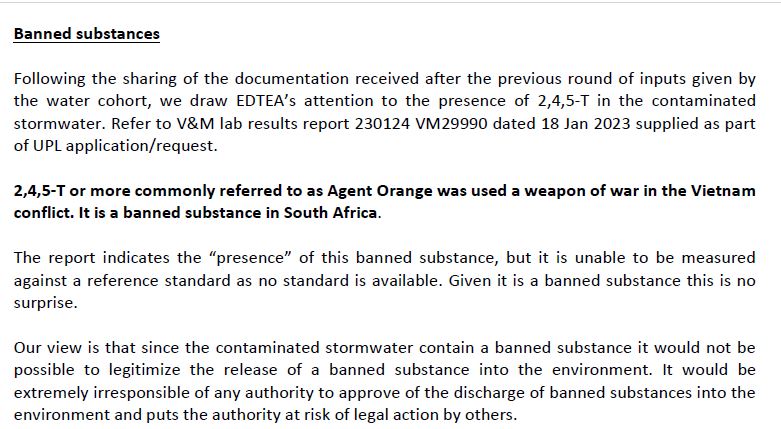 Extract of Ethekwini letter of 23 February 2023 to DEDTEA warning of banned pesticide 2,4,5-T.
UPL ‘never imported, stored or traded’ compound
Extract of Ethekwini letter of 23 February 2023 to DEDTEA warning of banned pesticide 2,4,5-T.
UPL ‘never imported, stored or traded’ compound
In its response to our queries, UPL confirmed on Monday that 2,4,5-T had indeed been found near Cornubia.
However, company spokesperson Marcel Dreyer stated, “No quantity of 2,4,5-T was stored at Cornubia prior to the fire, and UPL South Africa has never imported, stored, or traded this compound.
“On the advice of expert toxicologists, we understand that the presence of this compound is explained by the high temperatures caused by the fire, which combusted other agrochemical products and unavoidably created this compound in exceptionally insignificant quantities.”
He also denied that UPL had ever infringed on the independence of its consultants and stated that the company’s ultraviolet/ozone chemical decontamination process was recommended by experts and was “working with complete consistency” and generating treated water “equivalent to drinking water”.
(See UPL’s full responding statement further below.)
However, Dreyer has not provided a copy of the company’s toxicology report explaining exactly how 2,4,5-T came to be found at Cornubia, nor quantified his statement that the banned chemical was only present in “exceptionally insignificant quantities”.
In fact, Daily Maverick understands that the banned pesticide levels exceeded 1,000 ng/g in several test results.
In his letter to the authorities, the MSF’s Ridl states, “At least one chemical on the 2017 list of chemicals that are banned or restricted for use in South Africa is present in most samples tested by GeoMeasure Group, GroundTruth Consulting and MER. The chemical 2,4,5-T [was] found to be present in almost all water samples tested by the consultants.”
Ridl also pointed to a decision guidance document by the convention secretariat, which states that 2,4,5-T is banned in most countries because it contains a very potent dioxin contaminant (2,3,7,8 TCDD) that is toxic even in minute quantities. It had been found to cause cancer or foetal abnormalities in all animal species it was tested on.
“The chemical is simply not allowed to enter South Africa, and for very good reason,“ said Ridl, noting that the MSF was “astounded” that toxicologists in the UPL specialist team did not appear to have commented on the presence of this substance in the many samples taken since the UPL fire.
Urgent interdict
Surprisingly, the results of these tests have only recently come to public attention against the backdrop of a high court case in which the eThekwini Municipality sought an urgent interdict against UPL.
UPL says it has commissioned a new treatment plant to detoxify pesticide-contaminated water from its old storehouse rather than dumping it at great cost at a landfill near KwaDukuza.
Rachel Evatt, UPL’s head of legal affairs for Africa, told the court that the company’s treatment process ensured that contaminated water was rendered “clean and non-threatening to the environment”.
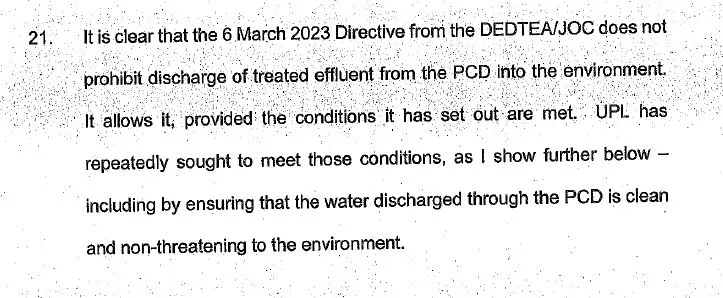 Extract of court affidavit by UPL Africa Head of Legal Rachel Evatt insisting that the company’s treated water is clean.
Extract of court affidavit by UPL Africa Head of Legal Rachel Evatt insisting that the company’s treated water is clean.
But senior eThekwini official Dr Andrew Mather told the court he was concerned that untreated water in UPL’s makeshift pollution control dam (PCD) had been on the point of overflowing at the end of October.
Despite UPL developing a “sophisticated” monitoring system to prevent this dam from overflowing into the Ohlanga River, it had overflowed at least twice after UPL allowed it to exceed the stipulated 30% storage capacity level, which was later revised to a 60% limit.
The court case is currently adjourned pending an interim court order, but behind the scenes, government officials have been engaged in acrimonious disputes over the best way of disposing of treated and untreated waste.
Earlier this month, the national Department of Water Affairs issued an “emergency directive” allowing UPL to discharge treated wastewater into a tributary of the Ohlanga River when its pollution control dam level exceeds 60%.
In another curious development, the KwaZulu-Natal Department of Environmental Affairs issued a pre-directive to the eThekwini Municipality and Tongaat-Hulett at the end of November, warning that they could be held in breach of their “duty of care” to the environment and a possible breach of environmental laws in connection with chemical pollution near the Cornubia site.
eThekwini and Tongaat-Hulett responded that the pre-directive appeared to be unreasonable and “illogical”, considering that the chemical pollution was caused by UPL, which was also directly responsible for the management and operation of the pollution control dam.
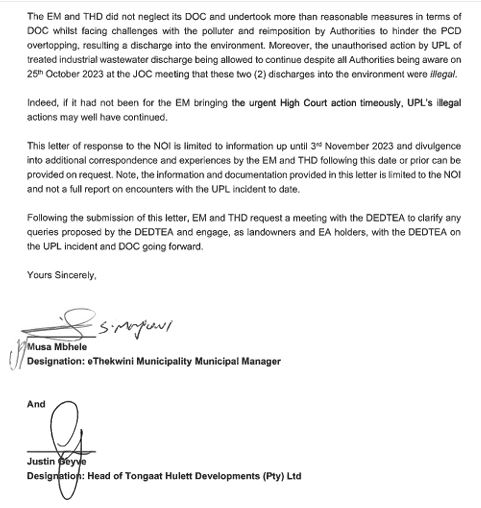 Extract of joint letter from Tongaat Hulett and Ethekwini Municipality to the KZN Department of Environmental Affairs.
Extract of joint letter from Tongaat Hulett and Ethekwini Municipality to the KZN Department of Environmental Affairs.
Both the city and Tongaat Hulett had taken proactive steps to halt pollution from the UPL-controlled dam, and eThekwini briefed lawyers to prevent imminent pollution at the end of October — though the provincial Department of Environmental Affairs did not appear to have taken any action against UPL to avert this threat.
“Indeed, if it had not been for the eThekwini Municipality bringing the urgent High Court action timeously, UPL’s illegal actions may well have continued,” Durban City Manager Musa Mbhele and Tongaat Hulett Development head Justin Geyve said in a joint letter to senior provincial Department of Environmental Affairs official Dr Bonginkosi Dlamini.
MSF considering legal action
The MSF is also worried about the government’s apparent failure to finalise criminal charges against UPL and the “lack of cooperation and coordination” between several government authorities that sit together on a Joint Operations Committee (JOC).
This committee (including officials from national, provincial and local government) was appointed soon after the fire to coordinate the clean-up and rehabilitation of the polluted areas and to provide expert technical advice, including possible health impacts on people living in the vicinity.
But, according to the MSF, the government committee now met very infrequently and what was once a group of nearly 100 officials had dwindled to “only five or six officials”.
“From the correspondence, it appears that UPL deals directly and separately with officials in the three spheres, at times, bypassing the authority with the most proximate mandate. This is undermining the legitimacy of the process,” the forum said in a letter in March.
In its most recent letter of concern last week, sent to the JOC chairperson, Sabelo Ngcobo, the MSF civil society watchdog said it was essential that government authorities exercised their mandates in a coordinated and cooperative manner.
However, the JOC had failed to respond to the forum’s concerns. The fact that eThekwini resorted to an urgent court application while the Department of Water and Sanitation recently granted a directive to UPL to discharge treated water emphasised the forum’s concern that authorities were still not working cooperatively.
The MSF’s Ridl has also called for clarity on the role of UPL specialist environmental and technical consultants.
“They might be appointed by UPL, but they must be independent and accountable to the authorities, and therefore the public. It is becoming clear that UPL considers the consultants to be under their control and answerable to them, first and foremost.
“This compromises the independence of the specialists and undermines public confidence that the true state of affairs is being disclosed. If the authorities have ceded control of the process to UPL, the public needs to know,” the forum suggested.
The MSF has also questioned the effectiveness of the UPL pollution treatment process, alleging that it had “not functioned consistently efficiently and cannot be relied upon.
“There are no time-series tests or repeatability tests to verify that the plant is able to yield a consistent quality of water, given the varying concentrations of contaminants in the PCD, depending on rainfall and other factors.
“In assessing whether the water is safe to discharge into the natural environment, testing has been required for only those substances that UPL is legally permitted to have or is willing to disclose.
“The UPL representative has only been able to say ‘to the best of my knowledge’ no banned substances were present in the warehouse prior to the fire. Even this qualification is questionable, given the laboratory analyses that show the presence of the banned chemical 2,4,5-T.”
No stakeholder consultation
The forum further notes that the choice of treatment plant was made without stakeholder consultation. Though the MSF had long advocated for onsite treatment of the contents of the PCD, using the most appropriate and best technology, several questions arose:
“What alternative technologies were considered? Was reverse osmosis considered? Why has the treatment plant failed at times or not functioned correctly? Do all the specialist consultants, within their fields of expertise agree that it is safe to discharge treated water into the tributary? Are all the authorities in agreement that the water is safe to discharge into the natural environment?”
Under these circumstances, the MSF considered the directive compelling UPL to discharge treated water into the Ohlanga tributary to be unlawful.
“While it was not intended that the MSF would be a vehicle for litigation, given the present threats to the environment and surrounding communities, it is considering a restructure to enable it to bring interdict proceedings against UPL and the authorities.”
The national Department of Water Affairs and Sanitation, the Department of Forestry, Fisheries and the Environment and eThekwini Municipality had not responded to Daily Maverick requests for comment sent on 8 December. DM
UPL’s full response to Daily Maverick’s questions
UPL’s view remains that this matter must be dealt with by the relevant authorities and in the appropriate forum, but there are several inaccuracies in your questions which must be addressed ahead of publication.
As indicated in our letter to your Editor in Chief, Mr Branko Brkic, we remind the Daily Maverick of its obligations under the Press Code of The Press Council of South Africa. Please see below a statement from UPL which should be published in full:
“No quantity of 2,4,5-T was stored at Cornubia prior to the fire, and UPL South Africa has never imported, stored, or traded this compound. On the advice of expert toxicologists, we understand that the presence of this compound is explained by the high temperatures caused by the fire, which combusted other agrochemical products and unavoidably created this compound in exceptionally insignificant quantities.
“UPL has never infringed on the independence of any consultant. The National Environmental Management Act ‘Section 30 Directive’ issued by the Department of Forestry, Fisheries and the Environment compels UPL to appoint and remunerate environmental consultants, but we neither exercise nor seek any influence over their work.
“Our UV/Ozone treatment process was recommended by experts and is working with complete consistency. Water treated from our Pollution Control Dam (PCD) is now registering between a 99-100% reduction in residual contamination, meeting Class 1 discharge limits which is equivalent to drinking water.
“We will continue to work closely with all parties, including with the Multi-Stakeholder Forum, in the appropriate forum, and will continue to provide updates on the environmental rehabilitation programme that has been underway since 2021.”
Marcel Dreyer
UPL Regional Head Africa, Middle East
The provincial Department of Environmental Affairs’ full response to MSF’s concerns
We wish to confirm receipt of this correspondence from Mr Ridl. We request that you afford us time to consider and respond to Mr Ridl’s letter.
We do not believe that it will be appropriate for us to respond to Mr Ridl via media. However, we undertake to update you once we have responded to Mr Ridl.
In addition, we wish to indicate that the decision by the department to issue pre-directives to both eThekwini and THD is informed by the legislative mandate.
As guided by the laws of the country, the department is obligated to hold both institutions to account in terms of their responsibilities as owners of the pieces of land in question and as holders of the authorisations issued to them in relation to the Cornubia integrated development.
The decision to issue these pre-directives was taken after due consideration and the department stands by its decision in this regard. DM






